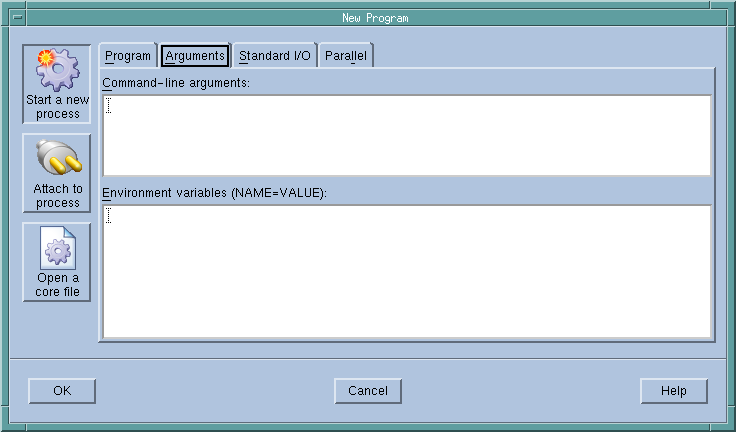Arguments Tab
Use this tab to define both the arguments and environment variables that TotalView passes to a process when it is next launched.
Command-line arguments
The arguments typed in this area are those that you would have entered if you were starting the program from a shell. If you were directly starting your program under TotalView control, these arguments are those you would enter using the TotalView -a command-line option.

This tab is identical to the Arguments tab that TotalView displays when you select the
Process > Startup Parameters command.
TotalView uses these arguments whenever it starts your program. In contrast, if you need to pass arguments to a starter process such as mpirun or poe, enter those arguments in the Parallel tab.
You can enter arguments in two ways:

Place them on separate lines.

Separate them with blanks.
If either case, an argument must be entered on one line. TotalView will rewrap what you type, so do not be concerned with how it looks in this window.
Here are some special cases:

If an argument contains embedded blanks, enclose the argument in quotation marks (
").

If an argument contains a quotation mark, precede it with a backslash.

If an argument contains a backslash character (
\), precede it with a second backslash.

TotalView interprets
\n as an embedded newline.
As the information in this page is just text, use standard dialog box editing commands to remove arguments you no longer need. If you delete these arguments before execution begins, TotalView does not use them.
Environment variables
Use this area to define additional environment variables that TotalView passes to a process when it is launched.
By default, a new process inherits TotalView environment variables, and a remote process inherits tvdsvr’s environment variables. Using this window, you can add new variables, change the value of existing variables, or delete an existing variable.
An environment variable is specified as name=value. For example, the following definition creates an environment variable named DISPLAY whose value is unix:0.0:
DISPLAY=unix:0.0
Place each environment variable on a separate line.
- Related Topics
